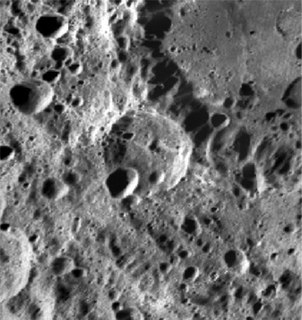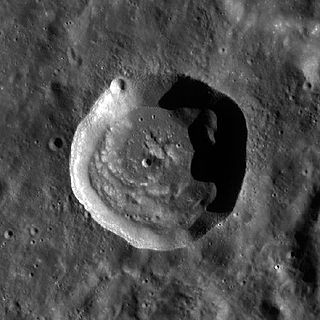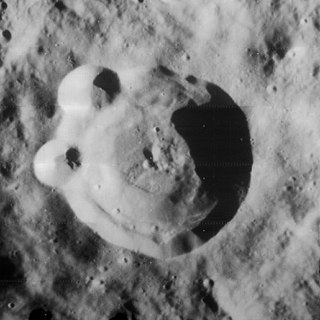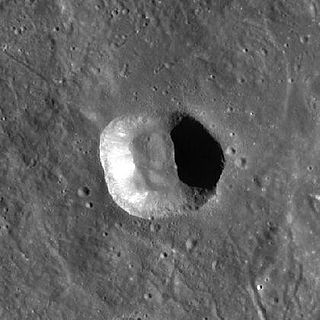
Beer is a relatively small lunar impact crater located on the Mare Imbrium, to the east of the crater Timocharis. It was named after German astronomer Wilhelm W. Beer. Just to the northwest is the matching twin Feuillée.

Aratus is a small lunar impact crater located on the highland to the south and east of the rugged Montes Apenninus range. It is a circular, cup-shaped crater with a relatively high albedo. It was named after Greek astronomer Aratus of Soli. To the east is the Mare Serenitatis, and to the southwest is the somewhat larger crater Conon. North-northeast of Aratus is the landing site of the Apollo 15 mission, just beyond Mons Hadley Delta.

Bombelli is a small lunar impact crater that is located in the highlands to the north of the Sinus Successus. It was named after Italian mathematician Raphael Bombelli. It was previously designated Apollonius T. The crater Apollonius is located to the east-southeast.

Bohnenberger is a lunar impact crater that lies near the east edge of the Mare Nectaris, in the foothills of the Montes Pyrenaeus mountain range that forms the perimeter of the mare. To the east beyond the mountains is the larger crater Colombo. The crater has a low rim along the north wall, and the floor is somewhat irregular with a ridge crossing the floor. There is a small crater along the western inner wall.

Eudoxus is a prominent lunar impact crater that lies to the east of the northern tip of the Montes Caucasus range. It is named after the Greek astronomer Eudoxus of Cnidus. It is located to the south of the prominent crater Aristoteles in the northern regions of the visible Moon. To the south is the ruined formation of Alexander, and the small crater Lamèch lies to the southwest.

Auwers is a small lunar impact crater that is located in the Montes Haemus mountain range at the south edge of Mare Serenitatis. It is named after German astronomer Arthur Auwers. It lies to the southeast of the crater Menelaus. The irregular rim of Auwers has a gap at the north-northwest edge, which allowed lava flows to reach the crater floor and flood the interior.

Calippus is a small lunar impact crater that is located on the eastern edge of the rugged Montes Caucasus mountain range in the northern part of the Moon. It was named after Greek astronomer Callippus of Cyzicus. It lies to the southwest of the crater remnant Alexander, to the northwest of the Mare Serenitatis.

Belyaev is a lunar impact crater that is attached to the outer edge of the Mare Moscoviense, on the far side of the Moon. It is a worn formation with a small crater pair overlaying the southern rim, and several smaller craters across the relatively irregular interior.

Conon is a small but prominent lunar impact crater that lies in the eastern foothills of the Montes Apenninus mountain range. The crater is named for the Greek astronomer Conon of Samos. Just to the west of Conon is the long mountainous ridge Mons Bradley. The nearest craters possessing an eponym are Galen, about 70 kilometres (43 mi) to the east, and Aratus, about the same distance to the northeast.

Drude is a lunar impact crater that lies on the far side of the Moon, in the rugged Montes Cordillera range that forms the outer ring around the Mare Orientale impact basin. It is located just behind the west-southwest limb, and this area is sometimes brought into sight from Earth during favorable librations. However, even at such times, the crater is viewed from the edge and little detail can be seen.

Dollond is a small lunar impact crater that is located in the central region of the Moon, to the north of the crater Abulfeda. It was named after British optician John Dollond. Due west of Dollond is Anděl. Dollond is circular and cone shaped, with a tiny floor at the midpoint of the sloping interior walls.

Daubrée is a lunar impact crater that is located to the southwest of the Mare Serenitatis, just to the west-southwest of the crater Menelaus in the Montes Haemus range. The small lunar mare Lacus Hiemalis lies along the southwest rim of Daubrée. The crater was named after French geologist Gabriel A. Daubrée. It was previously designated Menelaus S.

Elmer is a small lunar impact crater that is located to the south of Mare Smythii, near the eastern limb of the Moon. This crater is seen at a highly oblique angle from Earth, and the visibility is affected by libration. Elmer lies southwest of the crater Kreiken, and east-southeast of the larger Dale. This is a circular, bowl-shaped crater with an interior floor that occupies about half the total diameter.

Chant is a lunar impact crater that is located on the far side of the Moon, behind the southwest limb as seen from the Earth. It lies within the southwestern part of the blanket of ejecta surrounding the Mare Orientale, beyond the Montes Cordillera mountain ring. To the west-northwest is the large walled plain Blackett. Southward is the crater Mendel.

Couder is a small lunar impact crater that is located just behind the western limb of the Moon, in a region of the surface that is brought into view during favorable librations. It lies on the inner foothills of the Montes Cordillera, a ring-shaped mountain range that surrounds the Mare Orientale impact basin.

Eichstadt is a lunar impact crater that is located in the eastern section of the Montes Cordillera range that encircles the Mare Orientale impact basin. It lies toward the southwestern limb of the Moon, and so appears oblong when viewed from the Earth due to foreshortening. Over 200 kilometers to the east of Eichstadt are the craters Darwin and Lamarck, and to the south is Krasnov.

Krasnov is a lunar impact crater that is located in the southeastern part of the Montes Cordillera range, near the southwest limb of the Moon. From the Earth this crater appears foreshortened, and visibility can be affected by libration. To the north of Krasnov is the crater Eichstadt and to the southwest is Shaler, both along the edge of the Montes Cordillera mountain ring.

Chalonge is a lunar impact crater that is located on the far side of the Moon. It lies to the southwest of the larger crater Lewis, in the outer skirt of ejecta that surrounds the Mare Orientale impact basin. To the southeast are the Montes Cordillera, a ring of mountains that encircle the Mare Orientale formation.

Fleming is a large lunar impact crater that is located on the Moon's far side, and cannot be seen from the Earth. It lies about a crater diameter to the east-northeast of Hertz, and to the northwest of Lobachevskiy.

Fryxell is a small lunar impact crater that lies amidst the western inner ring of the Montes Rook. This crater is located on the Moon's far side, at the extreme edge of the region of the surface sometimes brought into view of the Earth due to libration. Even under rare conditions of favorable lighting and libration, this area would only be seen from the side amidst a rugged range of mountains. Thus this crater is best observed from orbit.



























